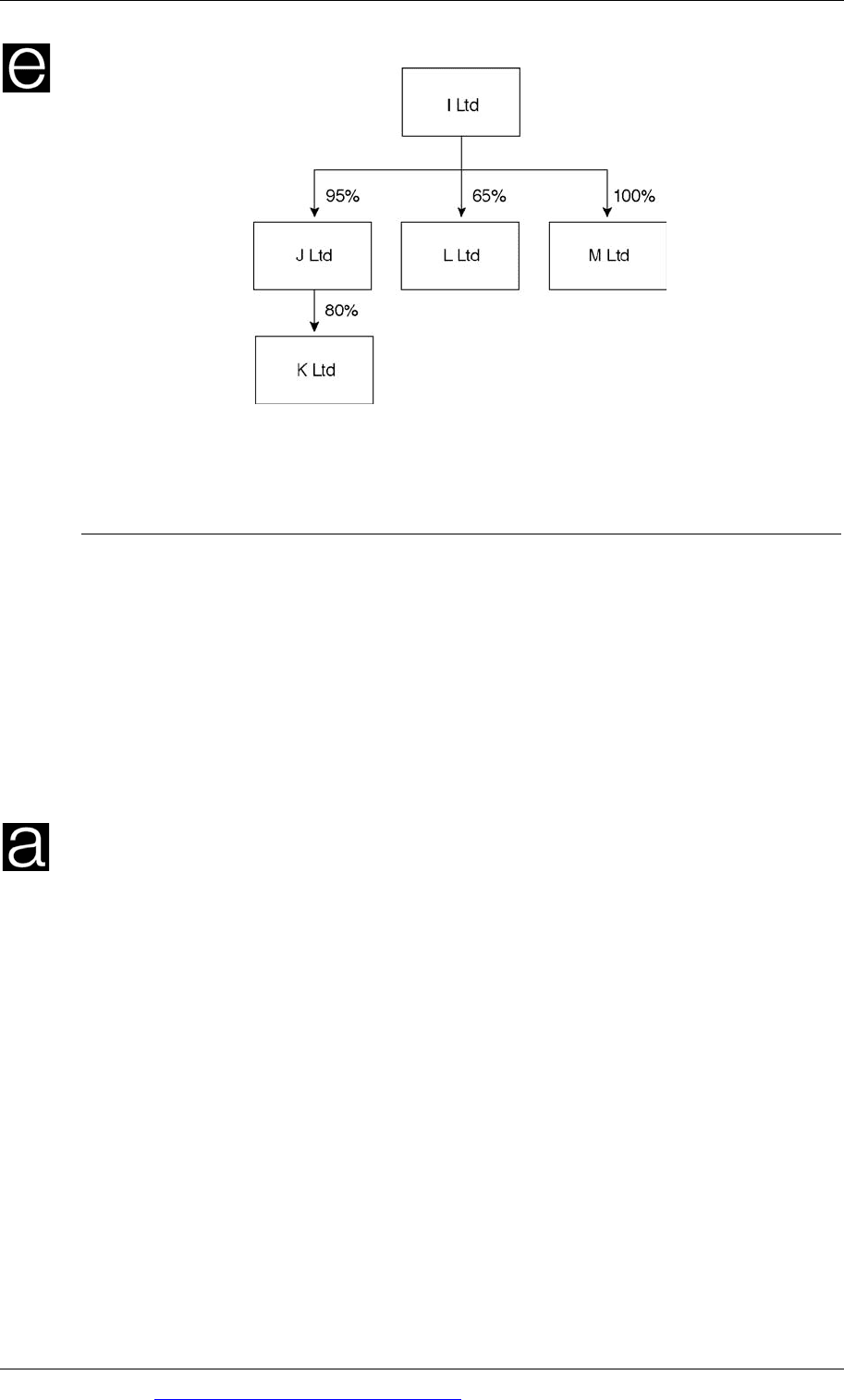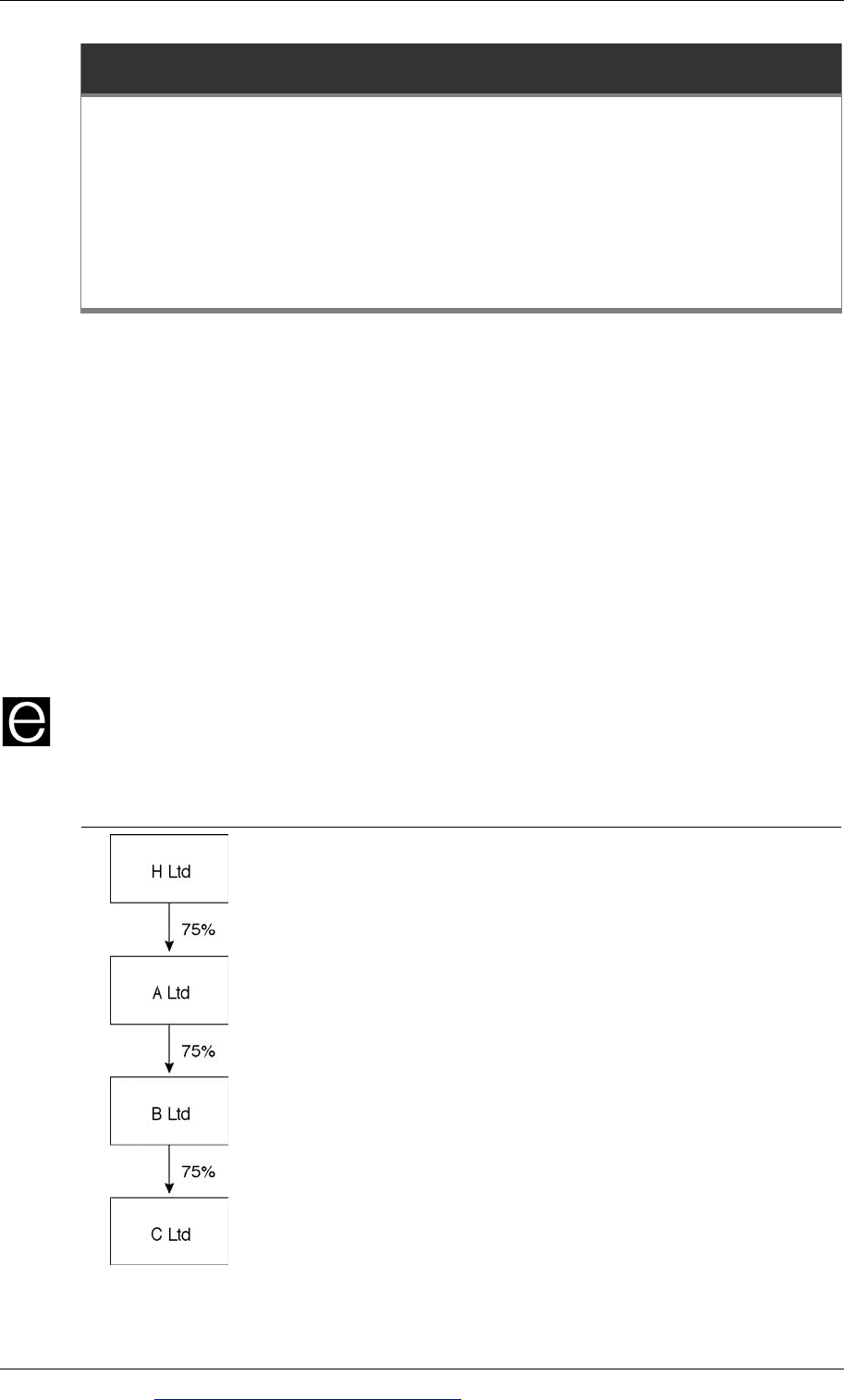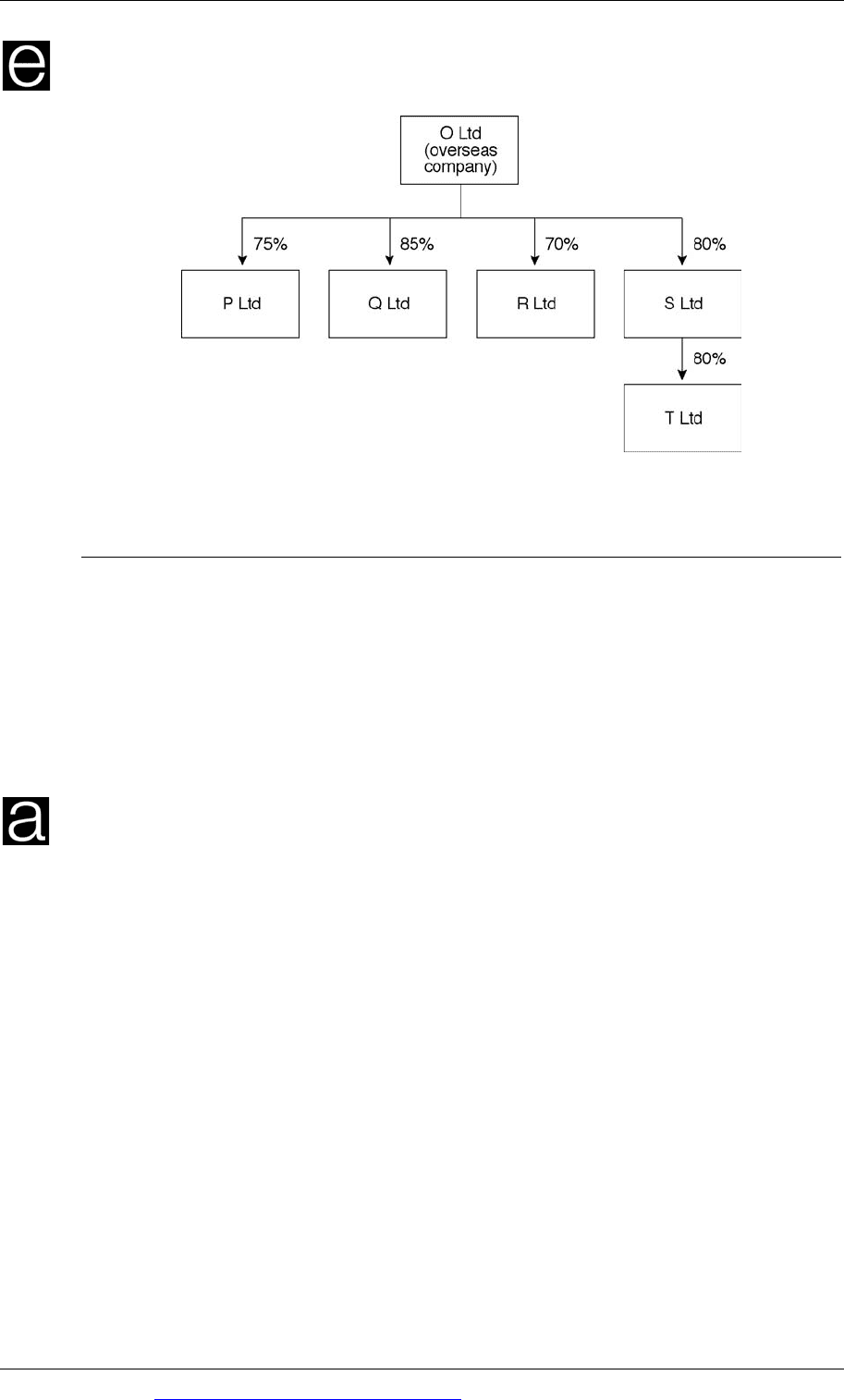ACCA F6 FA09 Study Text 2010
Подождите немного. Документ загружается.


Chapter 21: Group corporation tax
© EWP Go to www.emilewoolfpublishing.com for Q/As, Notes & Study Guides 375
Answer
K Ltd - Available profit
£
Trading income 28,000
Minus: Loss brought forward under s393(1)
(28,000)
–––––––––––––––––––––
–
–––––––––––
–
–
Nil
Interest income
20,000
Net chargeable gains
135,000
–––––––––––––––––––––––––––––––––
–
–
155,000
Gift Aid payment
(5,000)
–––––––––––––––––––––––––––––––––
–
–
Available profits of K Ltd 150,000
–––––––––––––––––––––––––––––––
–
–
–
–
G Ltd - Available loss
= All the current period trading loss of G Ltd (see notes below)
125,000
–––––––––––––––––––––––––––––––––
–
–
Maximum group relief
= Lower of available profits (£150,000) and available loss (£125,000)
125,000
–––––––––––––––––––––––––––––––––
–
–
Notes
(1) G Ltd can not surrender the £10,000 trading losses brought forward.
(2) G Ltd does not need to use its own loss first. It can surrender all the loss for its
current period.
(3) G Ltd cannot group relieve its Gift Aid payment because the payment can be
set off against the interest income in the CAP and is not therefore unrelieved.
2.5 Tax planning and group loss relief
In utilising the group loss provisions, the primary aim of the group should be to
save the maximum amount of corporation tax for the group as a whole.
Therefore, the rates of corporation tax applicable to each company in the current
CAP need to be considered.
In addition, the rate applicable to the loss-making company:
in the previous 12 months is important, for deciding whether or not a s393A
claim to carry back losses is beneficial (or the previous 36 months if an extended
carry back claim is to be made), and
in the future is important, for deciding whether or not losses should be carried
forward under s393(1).
To achieve the highest tax savings, the group will want to utilise the loss against the
profits suffering the highest effective marginal rate of tax.
It is necessary to compare each company’s profits of the appropriate CAP to the
relevant limits to decide the rate of tax applicable.

Paper F6 (UK): Taxation FA2009
376 Go to www.emilewoolfpublishing.com for Q/As, Notes & Study Guides © EWP
The relevant limits are the statutory limits divided by the number of associated
companies. In the case of a CAP of less than 12 months, the amount should also be
time-apportioned to match the length of the period.
As explained in the earlier chapter on loss relief, the effective marginal rates of tax
and therefore the optimum order of set-off are as follows:
Profit limits subject to adjustments
as referred to above
Effective marginal rate of
tax
Order for loss
allocation
FY07 FY08 FY09
£0 - £300,000 20% 21% 21% 3
£300,000 - £1,500,000 32½% 29¾% 29¾% 1
£1,500,000 + 30% 28% 28% 2
When allocating losses, the following points should be remembered:
s393A is an all or nothing relief. If the relief is claimed, the maximum possible
amount of loss must be used.
However, group relief is flexible. It can be surrendered in any amount and in
any direction to any other group company (or several group companies).
If cash flow is important to the group, note that:
carrying losses back under s393A could result in a repayment of tax
group relief reduces the group’s current tax liabilities
carrying losses forward delays the benefit of using losses.
Utilising losses with group relief: summary
As the primary aim is to minimise the overall group tax liability, the optimum use
of losses is to surrender them to the group companies in the following order.
First. To group companies paying 29¾%, but only the amount needed to bring
profits down to the relevant limit of £300,000 (as adjusted).
Second. To group companies paying 28% tax - these companies should be given
enough to bring profits down to the same relevant limit of £300,000 (as
adjusted), thereby saving tax at 28% initially and then 29¾%.
Finally, to group companies paying 21% tax.
Where several losses arise in a group, relief should first be given in respect of those
losses having the most restricted usage. For example:
Trading losses brought forward can only be set against the future trading profits
of the same loss-making company.
Capital losses can only be set against capital gains.

Chapter 21: Group corporation tax
© EWP Go to www.emilewoolfpublishing.com for Q/As, Notes & Study Guides 377
Example
The results of these companies for the year ended 31 March 2010 are as follows:
I Ltd J Ltd K Ltd L Ltd M Ltd
£ £ £ £ £
Trading profit/(loss) 340,000 (120,000) 34,000 134,000 75,000
Interest income 50,000 5,000 Nil 9,000 4,500
All companies are UK resident and none of the companies received any dividends.
Required
Calculate the PCTCT for each company assuming group relief is claimed in the most
tax-efficient manner, and calculate the tax saving achieved.
Answer
Start by identifying the number of associated companies, as this influences the tax
rates and therefore the decision on the optimum use of losses.
Number of associated companies = 5
Next, identify the group or groups which exist for group loss surrender purposes:
Loss relief group = I Ltd, J Ltd, K Ltd, M Ltd
Notes
(1) L Ltd is not included as I Ltd owns less than 75%.
(2) K Ltd is included as I Ltd has an effective interest of at least 75%
(95% × 80% = 76%).
Next: Establish the relevant limits for tax rate purposes:

Paper F6 (UK): Taxation FA2009
378 Go to www.emilewoolfpublishing.com for Q/As, Notes & Study Guides © EWP
Relevant limits
£
Small companies rate Lower limit 300,000 ÷ 5 60,000
Upper limit 1,500,000 ÷ 5 300,000
Next: Loss relief is then allocated to group companies in such a way as to maximise
the overall tax saving to the group.
I Ltd
J Ltd
K Ltd
L Ltd
M Ltd
£
£
£
£
£
Trading income 340,000
Nil
34,000
134,000
75,000
Interest income 50,000
5,000
Nil
9,000
4,500
PCTCT before loss relief 390,000
5,000
34,000
143,000
79,500
PCTCT = profits (no FII)
390,000
5,000
34,000
143,000
79,500
Marginal rate of relief 28%
21%
21%
29¾%29¾%
Best tax planning option
There is no advantage in J Ltd using its own loss as it would only save tax of £1,050
(£5,000 × 21%). There is also no advantage in surrendering any loss to K Ltd as it
will only save tax at 21%.
J Ltd cannot surrender losses to L Ltd as this company is not part of the loss group.
To save the most tax, I Ltd should surrender to M Ltd first to bring down its profits
to the small companies rate lower limit; then surrender to I Ltd and give the
maximum amount possible, which will save tax initially at 28% and then at 29¾%.
Amount of
loss used
Rate of tax
saving
Tax
saving
£
£
To M Ltd to bring down to £60,000 profits 19,500
29¾%
5,801
To I Ltd to bring down to £300,000 profits 90,000
28%
25,200
To I Ltd (the balance of the loss) 10,500
29¾%
3,124
120,000
34,125

Chapter 21: Group corporation tax
© EWP Go to www.emilewoolfpublishing.com for Q/As, Notes & Study Guides 379
Group chargeable gain provisions
Definition of a 75% group for the group chargeable gain provisions
An outline of the advantages of having a gains group
The treatment of intra-group transfers of capital assets
Claiming group rollover relief
Electing to make maximum usage of capital losses
Tax planning: using capital losses
3 Group chargeable gain provisions
3.1 Definition of a 75% group for the group chargeable gain provisions
Where one company owns, directly or indirectly, at least 75% of the ordinary share
capital of another company, the group chargeable gains provisions will apply.
Indirect sub-subsidiaries can also be part of the gains group. provided that the
holding company has an effective interest of over 50%.
Unlike group loss relief, a company can not be a member of two gains groups.
Example
Workings for answer
≥ 75% direct
holding test
≥
75% effective
interest test
> 50% effective
interest test
√ √ √
75% × 75% = 56.25%
√
X
√
56.25% × 75% = 42.1875%
√
X X

Paper F6 (UK): Taxation FA2009
380 Go to www.emilewoolfpublishing.com for Q/As, Notes & Study Guides © EWP
Required
Calculate the number of associated companies, state which companies form a loss
relief group and state which companies form a gains group.
Would there be a difference to the answer if A Ltd were an overseas company?
Answer
There are four associated companies, because at each link there is a more than a
50% interest.
Group loss relief groups
Gains group
Group 1:
H Ltd and A Ltd Group 1 H Ltd, A Ltd and B Ltd
Group 2: A Ltd and B Ltd
Group 3:
B Ltd and C Ltd
Notes:
(1) Neither B Ltd nor C Ltd can be
grouped with H Ltd for group loss
relief purposes as the 75% effective
interest test is not satisfied.
(2) A company can be a member of
more than one loss group.
Notes:
(1) C Ltd cannot be grouped with H Ltd
for group gains purposes.
(2) B Ltd and C Ltd cannot form another
gains group as a company can not be a
member of more than one gains group.
To determine the composition of a gains group, overseas companies in the group
are included. However, the advantages of having a gains group only apply to the
UK companies in the group. (This is the same as for group loss relief.)
Therefore, in the example above, if A Ltd was an overseas company there would be
no difference in the definitions of the groups. However:
H Ltd and B Ltd can take advantage of the capital gains provisions, but not with
A Ltd (overseas).
Only B Ltd and C Ltd can transfer losses to each other.
3.2 An outline of the advantages of having a gains group
There are three key advantages in having a gains group. These are the ability to:
transfer capital assets between group companies at nil gain / nil loss
claim group rollover relief, and
transfer capital gains and losses between group companies.
Each of these advantages is now considered in more detail.
3.3 The treatment of intra-group transfers of capital assets
Transfers of capital assets between members of a gains group are deemed to take
place so that no chargeable gain or loss arises on the transfer.

Chapter 21: Group corporation tax
© EWP Go to www.emilewoolfpublishing.com for Q/As, Notes & Study Guides 381
The asset is deemed to be transferred for a price equal to its cost to the transferor
plus indexation up to the date of the transfer. Any sale proceeds actually received
for the asset are ignored for tax purposes.
This treatment is automatic (i.e. a claim is not required).
When the recipient company sells the asset outside the group at a later date, the
normal chargeable gain computation applies, using the deemed acquisition cost as
allowable expenditure.
Example
N Ltd own 80% of O Ltd. Both companies prepare accounts to 30 June each year.
On 14 September 2003 N Ltd sold a warehouse to O Ltd for £200,000. N Ltd had
purchased the warehouse on 30 August 1999 for £120,000.
On 25 March 2009 O Ltd sold the warehouse for £300,000 to an unconnected
company, P Ltd.
Required
Calculate the gains arising in the year ended 30 June 2004 and year ended 30 June
2009.
Answer
Year ended 30 June 2004: Intra-group transfer from N Ltd to O Ltd
£
Deemed sale proceeds (ignore actual proceeds received. Use cost + IA) 132,360
Cost (August 1999) (120,000)
IA on cost - from August 1999 to September 2003
000,120£103.0=
5.165
5.165‐5.182
×
(12,360)
–––––––––––––––––––––––––––––––––
–
–
Chargeable gain Nil
–––––––––––––––––––––––––––––––––
–
–
Year ended 30 June 2009: Disposal by O Ltd outside the group to P Ltd
£
Sale proceeds 300,000
Deemed cost (132,360)
–––––––––––––––––––––––––––––––––
–
–
Unindexed gain 167,640
IA on cost - from September 2003 to March 2009
3601321580
5182
51823.211
, £ . =
.
.-
× (20,913)
–––––––––––––––––––––––––––––––––
–
–
Chargeable gain arising in O Ltd 146,727
–––––––––––––––––––––––––––––––––
–
–

Paper F6 (UK): Taxation FA2009
382 Go to www.emilewoolfpublishing.com for Q/As, Notes & Study Guides © EWP
3.4 Claiming group rollover relief
For the purposes of rollover relief (replacement of business asset relief), a gains
group is treated as a single entity.
Therefore, a gain arising on the disposal of a qualifying business asset (QBA) by one
company in the group, can be deferred against the base cost of a replacement QBA
acquired by another group company from outside the group.
The computation of rollover relief and the mechanics of deferral are the same as for
a single company. (If all the sale proceeds are reinvested, all the gain can be
deferred, etc).
3.5 Electing to make maximum usage of capital losses
Companies in a chargeable gains group can make an election to transfer the whole
or part of any chargeable gain or allowable loss to another group member.
The election enables chargeable gains to be matched against capital losses and
ensures that any net chargeable gains are taxed in the company paying the lowest
marginal rate of tax.
The election must be made within two years of the end of the CAP in which the
chargeable gain or loss arises. To be effective, both group companies must sign the
election.
3.6 Tax planning: using capital losses
The capital gains provisions provide the opportunity to save corporation tax by
making effective use of losses and crystallising gains in the group in the company
paying the lowest marginal rate of tax. In addition, gains may be deferred using
rollover relief claims.
The primary aim of the group is usually to minimise the overall group tax liability.
Therefore, as for group loss relief, the rates of corporation tax applicable to each
company in the current CAP need to be considered.
The election to match gains and losses is flexible. Any amount of a gain or loss can
in effect be transferred in any direction to any other group company (or several
companies).

Chapter 21: Group corporation tax
© EWP Go to www.emilewoolfpublishing.com for Q/As, Notes & Study Guides 383
Example
The companies pay tax at the following marginal rates:
O Inc
P Ltd Q Ltd R Ltd S Ltd T Ltd
40%
29¾%
28%
21% 28% 21%
Q Ltd disposed of a capital asset crystallising a gain.
Required
Explain what the group should do to minimise its corporation tax liability,
assuming the gain is not sufficiently large to affect the above rates of tax.
Answer
Gains group = O Inc, P Ltd, Q Ltd, S Ltd and T Ltd
The definition of the group includes O Inc. However, the chargeable gains reliefs
are only possible between the UK resident companies (i.e. P Ltd, Q Ltd, S Ltd and T
Ltd). Therefore, electing to transfer to O Inc is not an option.
R Ltd is not included in the group as O Inc owns less than 75%. Therefore electing to
transfer to R Ltd to take advantage of its 21% rate of tax is not an option.
T Ltd is included in the gains group as O Inc has an effective interest of over 50%
(i.e. 80% × 80% = 64%).
Q Ltd may therefore pay tax on the gain itself at 28% or elect to transfer the gain to P
Ltd, S Ltd or T Ltd. Of these companies, T Ltd pays tax at the lowest effective
marginal rate of tax of 21%.
Q Ltd should therefore elect to transfer the chargeable gain to T Ltd where it will be
taxed at 21%.

Paper F6 (UK): Taxation FA2009
384 Go to www.emilewoolfpublishing.com for Q/As, Notes & Study Guides © EWP
